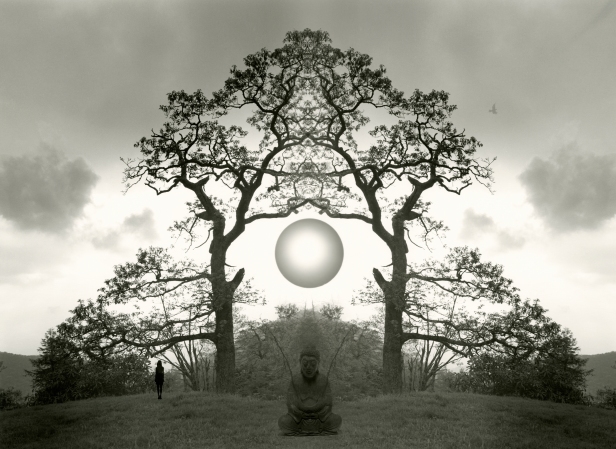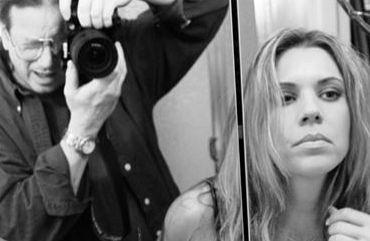Boats, for Jerry Uelsmann, often symbolize some kind of spiritual journey or transformation. Photo ©Jerry Uelsmann.
In the digital age, creating images that involve manipulation of reality, multiple exposures and compositing is relatively easy given software like Photoshop. But, in the days of film and analog processes, being able to accomplish similar results was much more difficult.
One of the masters of this is photographer Jerry Uelsmann, who has spent a career creating dreamlike, surrealist images using multiple exposures in the camera and making prints that combine different elements from various negatives using three to five or even more enlargers.
Jerry Uelsmann photos are often intended to convey a sense of mystery and leave interpretation and meaning up to the viewer. Photo ©Jerry Uelsmann. “I believe the mind sees more than the eye knows.” Photo © Jerry Uelsmann. Believability. Jerry Uelsmann has gotten requests from people wanting to know where he photographed this house. Photo © Jerry Uelsmann.
“I believe the mind sees more than the eye knows,” Uelsmann explains. “When I am assembling my final images most of the creativity is happening below the conscious level. And then I allow the viewers to assign any meaning to my work that they wish.”
Uelsmann began learning photography in the 1950s at a time when what as in vogue was “straight” photography – images (supposedly) created with no distorting manipulation. But he was also a student of art and was drawn to the surrealism of the 1920s and 1930s, painters like Rene Maigrette and photographer Man Ray. His photos are not documentary or narrative in nature but rather “allegorical surrealist imagery of the unfathomable” – very much in the surrealist tradition.
Post-visualization. Jerry Uelsmann believes the final image should be allowed to develop and evolve over time as is the case with painters and sculptors. Photo © Jerry Uelsmann. Color, in the opinion of Jerry Uelsmann, is too literal for his purposes in creating dream-like images. It can introduce to many distractions and distortions. Photo © Jerry Uelsmann.
“When I was learning photography,” he explains, “‘pre-visualization’ was the accepted approach to shooting photos. Photographers were supposed to have a clear idea of what the final image would look like after the film was developed and the print was made. But I have favored ‘post-visualization,’ allowing my creative efforts to develop and evolve over time in the darkroom. After all, this is the kind of process that describes what most painters and sculptors have done throughout history.”
Uelsmann also believes that is no one “right answer” when it comes to art. So he has often used the same photographic elements in different combinations to create different versions of images he has done before. A mountain might be combined with a floating eye in one image and a female nude in another.
Elements like the hands, the house or the clouds might well end up being used in other Uelsmann photos. “There is no one right answer” in art he believes. Photo © Jerry Uelsmann.
He work is intended to create a sense of mystery, so he is often surprised when he is contacted and asked where someone can find the rock with the door in it or the house with heavy roots extended out from below that appear in his images. He gets satisfaction out of surrealism done with such fine craft that it become this believable.
Jerry Uelsmann is able to make multiple prints of his very complex photo-montage images using a darkroom full of enlargers. He puts different elements of an assemblage in different enlargers and then moves the same piece of paper from one enlarger to the other, dodging and burning as necessary to create the illusion he is aiming for. This way he can duplicate the process many times to get virtually identical results.
Cupped hands is a recurring motif in photos © Jerry Uelsmann.
He also does multiple exposures in camera on the same negative, a technique that goes well back into the 19th century.
Uelsmann points out that image and technique go hand in hand. As he developed his technical skills over time he found himself able to achieve results that were beyond his ability some years earlier.
Surrealist painters like Rene Magritte advocated looking to dreams and the unconscious to find subjects of art. Photographer and painter Man Ray was a surrealist and a particular favorite of Jerry Uelsmann.
He also prefers working in black and white. Color, he believes, can be distracting and distorting when it comes to creating his mythic and symbolic images. Of course, in the digital age, where color can be so manipulated, the next generation of photographers with surrealistic visions will no doubt create a symbolic visual language that exploits the potentials of the full color spectrum.
But on the subject of digital possibilities, you would think the ease with which images can be distorted, manipulated and combined in the age of Photoshop would result in a lot of photographs with the impact and importance of those created by Jerry Uelsmann. But at this point this has not really happened. Which illustrates the fact that cameras and technology do not create great photographic art.
Great photographic artists do. Like Jerry Uelsmann.
Jerry Uelsmann – head in the clouds, feet in the darkroom. Photo © Jerry Uelsmann RECENT WORK
“I am still in the darkroom.” – Jerry Uelsmann 2018 Southern Gothic. Photo © Jerry Uelsmann 2018 Paradox Islans LR. Photo © Jerry Uelsmann 2018 Apocalypse III. Photo © Jerry Uelsmann 2017 Untitled (Moa doors). Photo © Jerry Uelsmann 2017 Memory Door. Photo © Jerry Uelsmann 2016 Myth of the Tree_lowres. Photo © Jerry Uelsmann 2015 Meditation Tree. Photo by Jerry Uelsmann Jerry Uelsmann received a Guggenheim Fellowship in 1967 and a National Endowment for the Arts Fellowship in 1972. He is a Fellow of the Royal Photographic Society of Great Britain, a founding member of The Society of Photographic Education and a former trustee of the Friends of Photography. Uelsmann’s work has been exhibited in more than 100 individual shows in the United States and abroad over the past thirty years. His photographs are in the permanent collections of many museums worldwide, including the Metropolitan Museum of Art and the Museum of Modern Art in New York, the Chicago Art Institute, the International Museum of Photography at the George Eastman House, the Victoria and Albert Museum in London, the Bibliotheque National in Paris, the National Museum of American Art in Washington, the Moderna Museet in Stockholm, the National Gallery of Canada, the National Gallery of Australia, the Museum of Fine Arts in Boston, the National Galleries of Scotland, the Center for Creative Photography at the University of Arizona, the Tokyo Metropolitan Museum of Photography, and the National Museum of Modern Art in Kyoto.
**********************************
Bill Dobbins is a veteran photographer and videographer located in Los Angeles who has exhibited his fine art images in two museums and a number of galleries and has published eight print and 16 eBooks, including two fine art photo books:
WEBSITES


























